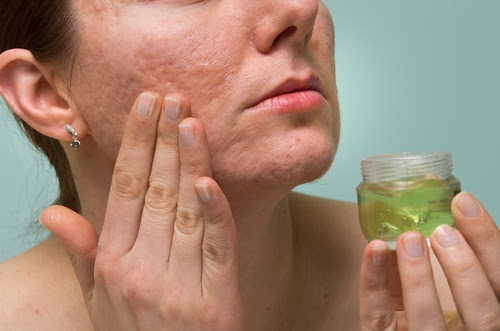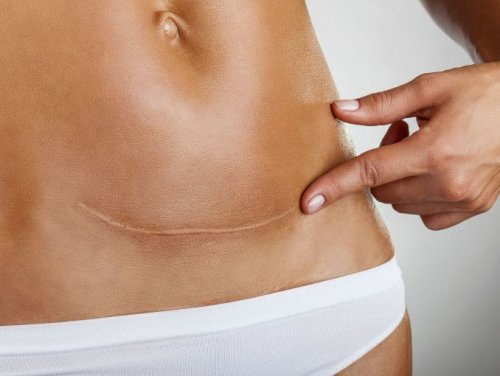Today's Best Advice for Treating and Reducing the Appearance of Scars

Scars are the result of cuts or lesions on skin that occur for different reason. The appearance of scars on the body is not always welcomed, for aesthetic reasons.
In fact, many women go so far as to cover them up, camouflage them, or even remove them completely through one technique or another.
When the human body is wounded, it begins the process of repairing the damaged tissue. Thanks to this process, the body can heal from bumps, cuts, and other types of small wounds.
This is the scarring process and it consists of several stages. But while this process takes place naturally, many times it is not enough to completely eliminate the mark from the skin.
Those scars that are in plain sight tend to be the first to cause people to look for a solution. In fact, visible scars can even have a negative effect both on a person’s body image and their self-esteem.
And this, of course, can produce further consequences.
The impact of scars
The scars left behind by Cesarean section are very common, but they are not always well received. Many women wish their scars were not so evident, and look for ways to diminish them or erase them completely.
In the same way, many people hope to get rid of marks left by burns, cuts, acne – or at least make them less obvious. Apparently, besides just physical or aesthetic motivations, there are also psychological reasons behind the rejection of a scar.
Many times, the story behind our physical scars is not a pleasant one.
Fortunately, medical advances and the application of certain traditional methods have allowed people to reduce or eliminate the appearance of scars.
Having the option of reducing the presence of scars or making them disappear is a useful alternative. In fact, it’s something that’s possible for anyone.

Some scars are more or less faint, such as the scar left behind after an appendix surgery during infancy. Other surgical procedures, however, can leave more obvious marks, such as the removal of varicose veins or the scar left behind by thyroid surgery.
Factors that influence the scarring process
Some people scar better than others. In fact, the same surgical procedure, like C-section, can leave some women with a pronounced scar, while other women only have an almost invisible line.
Why is this? Generally, this has to do with skin type, the location of the scar, the type of wound, age, and even diet. All of these factors influence a body’s ability to heal itself.
Don’t forge that the element, or protein, that allows our body’s to repair wounded tissue is collagen.
It’s also interesting to know that the scarring process can take anywhere from 12 to 18 months. Therefore, at least a year can go by before you can observe the final aspect of a scar.
Keloids and C-section scar hypertrophy
Keloids are scars that are difficult to heal. They come from burns, varicose veins and deep surgical wounds.
Surgeries in the abdomen or perineal region, such as C-section and episiotomy, can bring on the appearance of keloids. In these cases, an excessive scarring process leaves a hypertrophied mark.
Read also: Get your figure back in no time!
Natural treatment options for scars

Aloe vera
- Aloe vera is very beneficial to the skin. Whether it be to relieve burns or lighten scars, aloe vera’s hydrating and regenerating properties are great for your skin. For that reason, it is one of the most common natural elements used in skin care.
- Polysaccharide and lignin, two components founds in aloe vera, help to regenerate and hydrate skin, and care for your skin’s pH.
Rosehip oil
- Rosehip is a type of thorny bush with exceptional virtues for the treatment of stretch marks, scars, burns, dry skin, etc.
- The oil from this plant assists in the renewal of cells in each of the skin’s layers. Furthermore, it takes part in the skin’s production of collagen and elastin.
Cocoa butter
- Cocoa butter, like rosehip oil, is also used for skin care purposes. In fact, it is one of the best ways to treat scars naturally.
- This vegetable extract is a great source of hydration. It smooths over scarred skin and and slowly reduces roughness and scaliness, restoring its natural elasticity.
Reduce the presence of scars through specialized techniques

Turning to centers that are specialized in treating scars is a simple and effective option that we have within our reach.
At these centers, specialists employ techniques to deal with everything from acne scars to scars caused by traumatic occurrences, burns, and surgical interventions.
The most common techniques include
- Z-plasty: A plastic surgery technique that improves the function and aesthetic appearance of scars. Through this procedure, professionals can stretch, relax or realign scars to make them less noticeable.
- Lipostructure: A process that takes fat from one area of the body and injects it into another area to fill in defects or dents left behind by previous trauma or surgery.
- Dermoabrasion: Dermoabrasion is a technique performed by trained medical specialists specifically on scars on the skin’s surface, such as acne scars. By wearing down the upper to middle layers of skin, the procedures diffuse lines and reduce the appearance of scars.
- Laser technology: The use of laser is, without a doubt, one of the most common interventions. Laser technology allows scar pigment to be destroyed, thus homogenizing skin color.
- Hyaluronic acid: A substance that facilitates the smoothing over of scar tissue.
When it comes to treating scars, there are a number of options and strategies. It doesn’t matter where our scars are located or how long we’ve had them.
What matters is that we feel good about ourselves and are happy with what we see in the mirror.
Scars are the result of cuts or lesions on skin that occur for different reason. The appearance of scars on the body is not always welcomed, for aesthetic reasons.
In fact, many women go so far as to cover them up, camouflage them, or even remove them completely through one technique or another.
When the human body is wounded, it begins the process of repairing the damaged tissue. Thanks to this process, the body can heal from bumps, cuts, and other types of small wounds.
This is the scarring process and it consists of several stages. But while this process takes place naturally, many times it is not enough to completely eliminate the mark from the skin.
Those scars that are in plain sight tend to be the first to cause people to look for a solution. In fact, visible scars can even have a negative effect both on a person’s body image and their self-esteem.
And this, of course, can produce further consequences.
The impact of scars
The scars left behind by Cesarean section are very common, but they are not always well received. Many women wish their scars were not so evident, and look for ways to diminish them or erase them completely.
In the same way, many people hope to get rid of marks left by burns, cuts, acne – or at least make them less obvious. Apparently, besides just physical or aesthetic motivations, there are also psychological reasons behind the rejection of a scar.
Many times, the story behind our physical scars is not a pleasant one.
Fortunately, medical advances and the application of certain traditional methods have allowed people to reduce or eliminate the appearance of scars.
Having the option of reducing the presence of scars or making them disappear is a useful alternative. In fact, it’s something that’s possible for anyone.

Some scars are more or less faint, such as the scar left behind after an appendix surgery during infancy. Other surgical procedures, however, can leave more obvious marks, such as the removal of varicose veins or the scar left behind by thyroid surgery.
Factors that influence the scarring process
Some people scar better than others. In fact, the same surgical procedure, like C-section, can leave some women with a pronounced scar, while other women only have an almost invisible line.
Why is this? Generally, this has to do with skin type, the location of the scar, the type of wound, age, and even diet. All of these factors influence a body’s ability to heal itself.
Don’t forge that the element, or protein, that allows our body’s to repair wounded tissue is collagen.
It’s also interesting to know that the scarring process can take anywhere from 12 to 18 months. Therefore, at least a year can go by before you can observe the final aspect of a scar.
Keloids and C-section scar hypertrophy
Keloids are scars that are difficult to heal. They come from burns, varicose veins and deep surgical wounds.
Surgeries in the abdomen or perineal region, such as C-section and episiotomy, can bring on the appearance of keloids. In these cases, an excessive scarring process leaves a hypertrophied mark.
Read also: Get your figure back in no time!
Natural treatment options for scars

Aloe vera
- Aloe vera is very beneficial to the skin. Whether it be to relieve burns or lighten scars, aloe vera’s hydrating and regenerating properties are great for your skin. For that reason, it is one of the most common natural elements used in skin care.
- Polysaccharide and lignin, two components founds in aloe vera, help to regenerate and hydrate skin, and care for your skin’s pH.
Rosehip oil
- Rosehip is a type of thorny bush with exceptional virtues for the treatment of stretch marks, scars, burns, dry skin, etc.
- The oil from this plant assists in the renewal of cells in each of the skin’s layers. Furthermore, it takes part in the skin’s production of collagen and elastin.
Cocoa butter
- Cocoa butter, like rosehip oil, is also used for skin care purposes. In fact, it is one of the best ways to treat scars naturally.
- This vegetable extract is a great source of hydration. It smooths over scarred skin and and slowly reduces roughness and scaliness, restoring its natural elasticity.
Reduce the presence of scars through specialized techniques

Turning to centers that are specialized in treating scars is a simple and effective option that we have within our reach.
At these centers, specialists employ techniques to deal with everything from acne scars to scars caused by traumatic occurrences, burns, and surgical interventions.
The most common techniques include
- Z-plasty: A plastic surgery technique that improves the function and aesthetic appearance of scars. Through this procedure, professionals can stretch, relax or realign scars to make them less noticeable.
- Lipostructure: A process that takes fat from one area of the body and injects it into another area to fill in defects or dents left behind by previous trauma or surgery.
- Dermoabrasion: Dermoabrasion is a technique performed by trained medical specialists specifically on scars on the skin’s surface, such as acne scars. By wearing down the upper to middle layers of skin, the procedures diffuse lines and reduce the appearance of scars.
- Laser technology: The use of laser is, without a doubt, one of the most common interventions. Laser technology allows scar pigment to be destroyed, thus homogenizing skin color.
- Hyaluronic acid: A substance that facilitates the smoothing over of scar tissue.
When it comes to treating scars, there are a number of options and strategies. It doesn’t matter where our scars are located or how long we’ve had them.
What matters is that we feel good about ourselves and are happy with what we see in the mirror.
This text is provided for informational purposes only and does not replace consultation with a professional. If in doubt, consult your specialist.








